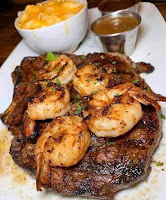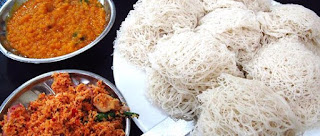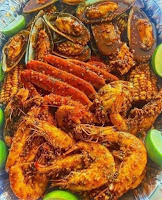RICE AND CURRY
SRI LANKAN FOOD
RICE AND CURRY

ශ්රී ලංකාවේ ආහාර-இலங்கை உணவு
When it comes to Sri Lankan cuisine, you cannot expect anything less because Sri Lanka is a multi-cultural nation. The cuisine of our nation is renowned for its vast variety of rice specialties, spices, herbs, seafood, seasonal vegetables and fruits, and of course, legumes. Our country is full of regional flavors.
 |
| SEAFOOD |
While many Sinhalese cuisine products are rooted from china agriculture, culture is crucial to the country's food scene. There will be a variety of traditional Sri Lankan foods available, including milk rice, sweetmeats, and spicy curries as accompaniments, for everything from the most revered and auspicious Sinhala and Hindu New Year to numerous day-to-day occasions and festivals.
The primary ingredients in many of these meals are rice, rice flour, and coconut, and seafood is a significant component of Sri Lankan cuisine. The traditional "Rice and Curry" dinner is the preferred option for most Sri Lankans, who favor vegetable curries. A list of Sri Lankan hot spices gives the curries their intense flavor and color. These spices enhance the flavor of the food while also giving it ayurvedic benefits.
 |
| Rice and Curry |
Since Sri Lankan cuisine varies depending on the region, you may anticipate eating the same meal prepared in different ways and with varied flavors. For instance, the food from the southern region of Sri Lanka has a particular flavor and is mostly seafood was amalgamated. The unusual spicy fish dish "ambulthiyal" is made in the South of the island and uses a thick gambooge (goraka) paste, making it distinct from other sections of the island.
SEAFOODS
The seafood sector in Sri Lanka is unique. It not only benefits from being on a tropical island, but also from the conventional and cutting-edge technology that the sector has to offer. And for this reason, Sri Lankan seafood goods come in a huge variety and lead the market.
QUALITY GUARANTEED
Seafood products from Sri Lanka are of the highest quality because they are caught in the warm seas of the Indian Ocean. Whether they are choosing fish, mollusks, or crustaceans, our fishermen and divers make certain they choose the highest quality products. Schools of marine life that are thriving in our tropical seas are taken by hand utilizing equipment that is both environmentally safe and non-harmful. We maintain our reputation for providing the highest-quality products for international markets by adhering to the finest practices in the industry during processing and production. Currently, Sri Lanka has roughly 32 processing facilities that have received EU approval. And we adhere to the rules established by importing nations as well as to HACCP, BRP, Friend of Sea, and other food safety standards and other environmental needs for food security.
Sri Lank Any type of marine life that humans consider to be food is considered seafood, with fish and shellfish topping the list. Bivalve molluscs like clams, oysters, and mussels, as well as cephalopods like octopus and squid, are examples of shellfish. Also included are crustaceans like shrimp, crabs, and lobster, as well as echinoderms (e.g. sea cucumbers and sea urchins). In the past, people have eaten seals and other marine creatures like cetaceans (whales and dolphins) for food, however this practice is less common now. Around the world, especially in Asia, edible sea plants such certain seaweeds and microalgae are frequently consumed as sea vegetables.a is gifted with a strategic location close to the equator and favorable climatic conditions for the production of seafood. The Sri Lankan fisheries industry includes coastal, interior, and aquaculture fishing in addition to the seafood harvest obtained from offshore and deep-sea fishing. Because marine fish production accounts for over 90% of Sri Lanka's total fish harvest, our clients have a wide variety of seafood options. Sri Lanka is renowned for various exotic cuisines that can only be found in the orient, including a variety of finfish species, crabs, prawns, shrimp, and molluscs. And whether you enjoy playing it or are an adventurous seafood explorer, there is something for everyone.
Sri Lankan Traditional Foods
- Appa (Hoppers)
In Sri Lanka, appa is the preferred comfort food. The majority of Sri Lankans, like me, would like it at any time of day. Hoppers feature a crunchy batter exterior and a squishy interior. Appa will keep you reaching across the dining table for more when paired with a flavorful curry.
 Wheat flour, rice flour, coconut milk powder, dried yeast, salt, warm water, and, if wanted, sugar, are the ingredients used to make the batter. You can prepare several batches of this well-liked meal using the batter, which can be stored in the refrigerator for up to three days.
Wheat flour, rice flour, coconut milk powder, dried yeast, salt, warm water, and, if wanted, sugar, are the ingredients used to make the batter. You can prepare several batches of this well-liked meal using the batter, which can be stored in the refrigerator for up to three days.
2. Idiyappam (String Hoppers)
Although Idiyappam and appa appear to be extremely similar at first appearance, they are actually totally different foods. A batter made of rice flour, salt, and hot water is used to make idiyappam.The batter is placed into a special tool, squeezed into strings that resemble noodles, and then steamed. To obtain the optimal consistency with string hoppers, tons of effort and perseverance are needed.
With dishes like beef curry, chicken curry, dhal, sambol, and many more, string hoppers go incredibly well. You'll frequently find yourself devouring more of them than you could ever anticipate while eating them with curries and sambol!
3. Kottu Roti (Cut Roti)
This meal has evolved into Sri Lanka's national dish (hypothetically). Every food store in Sri Lanka sells kottu, and it can be found there.This meal was initially prepared in Sri Lankan streets. Due to its popularity, this will now undoubtedly be on the menus of even five-star hotels.
If you ever travel to Sri Lanka, you must try this fantastic spicy cuisine; otherwise, your trip will not be considered complete.Because it was intended to be a one-pot dinner, the dish is made so that you can stand while eating it. Given how raucous it is when street vendors are preparing it, you wouldn't want to miss it in Sri Lanka.
In Sri Lanka, appa is the preferred comfort food. The majority of Sri Lankans, like me, would like it at any time of day. Hoppers feature a crunchy batter exterior and a squishy interior. Appa will keep you reaching across the dining table for more when paired with a flavorful curry.

Wheat flour, rice flour, coconut milk powder, dried yeast, salt, warm water, and, if wanted, sugar, are the ingredients used to make the batter. You can prepare several batches of this well-liked meal using the batter, which can be stored in the refrigerator for up to three days.
2. Idiyappam (String Hoppers)
Although Idiyappam and appa appear to be extremely similar at first appearance, they are actually totally different foods. A batter made of rice flour, salt, and hot water is used to make idiyappam.
The batter is placed into a special tool, squeezed into strings that resemble noodles, and then steamed. To obtain the optimal consistency with string hoppers, tons of effort and perseverance are needed.
With dishes like beef curry, chicken curry, dhal, sambol, and many more, string hoppers go incredibly well. You'll frequently find yourself devouring more of them than you could ever anticipate while eating them with curries and sambol!
3. Kottu Roti (Cut Roti)
This meal has evolved into Sri Lanka's national dish (hypothetically). Every food store in Sri Lanka sells kottu, and it can be found there.
This meal was initially prepared in Sri Lankan streets. Due to its popularity, this will now undoubtedly be on the menus of even five-star hotels.
If you ever travel to Sri Lanka, you must try this fantastic spicy cuisine; otherwise, your trip will not be considered complete.
Because it was intended to be a one-pot dinner, the dish is made so that you can stand while eating it. Given how raucous it is when street vendors are preparing it, you wouldn't want to miss it in Sri Lanka.
4. Kiribath (Milk Rice)
We Sri Lankan's welcome the new year, whether it is Roman or the traditional Sinhalese new year, with a traditional Coconut Milk Rice dish called Kiribath. Every significant moment or auspicious occasion in a Lankan's life involves Kiribath.
These white diamonds are an unmistakable sight to garnish the tables, whether it's for a wedding, a graduation, or a new family member. It is prepared using fresh rice in a fresh clay pot as a representation of prosperity and new beginnings.
5. Fish Curry and Mixed Rice
6. Sri Lankan Dhal Curry (Parippu)
.jpg)
Dhal curry is one of the most commonly consumed staple dishes in Sri Lankan cuisine.
The dhal, usually masoor dhal which are red lentils, are often cooked in a beautiful blend of spices, and then a few spoons of coconut milk are added to create a rich stew.
Dhal curry is omnipresent in Sri Lanka, and it’s consumed with all forms of rice and bread.
7.Deep Fried Chicken Fried Rice
QUITE SPICE. Indian cuisine has influenced Sri Lankan cuisine, as have colonizers and international traders.
Most South Indian cuisine is significantly less spicy than Sri Lankan food, and several hot Sri Lankan dishes are thought to be among the hottest in the world in terms of their chili content.
NEGOMBO, A CITY ON THE WEST COAST OF SRI LANKA, NORTH OF THE CAPITAL COLOMBO, IS A CITY I RECENTLY HAD THE OPPORTUNITY TO VISIT. Many seafront restaurants in Negombo will welcome you with delectable food and gorgeous ambiance. A VERY EXTRAORDINARY PLEASURE IS EATING FOOD BY THE SEA.
8. Pol Sambol
The Sri Lankan dish known as pol sambol is one of the most delectable dishes that Sri Lanka has given to the world, despite being one of the simplest to prepare.
It emphasizes the powerful coconut, a fruit that is essential to Sri Lankan cuisine. The only ingredients in pol salmbol are shredded coconut, chili powder or dried chilies, lime juice, red onions, and salt, but every bite tastes miraculous.
For hours at a time, I could nibble on pol sambola. The dish pol sambola goes well with bread, roti, rice, and curry. Actually, it tastes great when eaten simple or even with other foods.
9. PITTU – FLOUR AND COCONUT FUNNEL CAKES
After a break, it is so pleasant to be back. Everyone is occupied with summertime activities and festival celebrations. On April 14th, Keralans celebrated Vishu, the Malayalam calendar's equivalent of New Year. Seeing the sky lit up with fireworks and spending time with family is so much pleasure. The primary highlights are the Vishu Kani and the saddya (the feast).
This article discusses a popular breakfast dish served in every Keralan home. In our home, it is prepared at least once a week. Rice Puttu, Ragi Puttu, Irachi Puttu, Chemeen (Prawns Puttu), and Chiratta Puttu are just a few of the many puttu variants we provide. These days, there are a lot more options readily available on the market.
10. Pol Roti
Sinhalese for "coconut roti" or "coconut flatbread" is "pol roti" (). It's a style of flatbread manufactured in Sri Lanka that is particularly well-liked. It can be had as a snack or even for breakfast, lunch, or dinner. It has great versatility!
It's also quite easy to make because it doesn't require any leavening (yeast, baking powder, or baking soda). With the help of water or coconut milk, shredded coconut, flour, and a few other ingredients are combined and made into a dough.











.jpg)
.jpg)
















